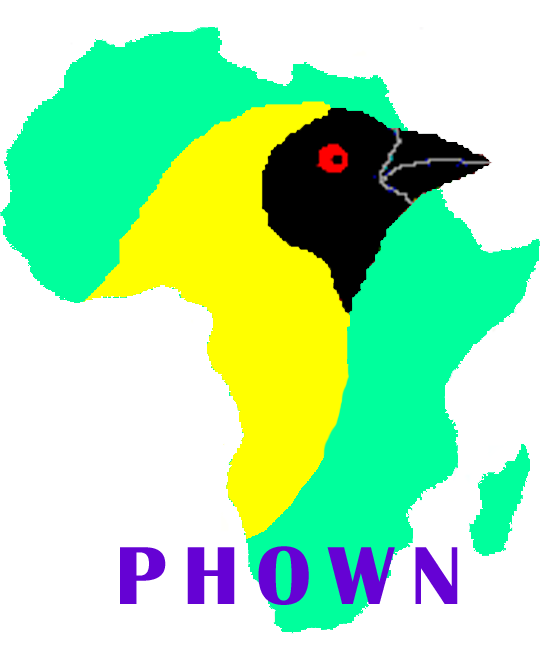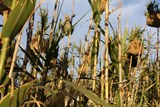Weaver species
Choose different species from drop-down list and press 'Go' button. See Full species list.Chestnut-mantled Sparrow-Weaver Plocepasser rufoscapulatus
IUCN: Least concern Discovery: 088Categories: Plocepasser, cooperative,
News items about species
Discovery
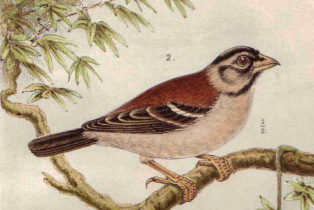
figure from Buttikofer (1888) 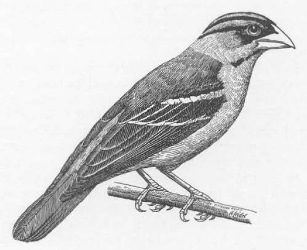
figure from Chapin (1954) 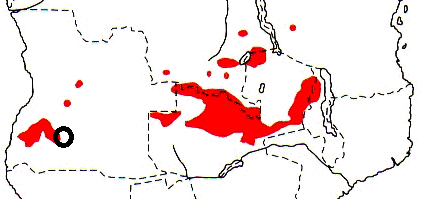
distribution, type locality circled IntroductionThe Chestnut-mantled Sparrow-Weaver was formally described by Dr Johann Buttikofer, a Swiss zoologist. Buttikofer undertook two zoological expeditions to the Republic of Liberia, so he had some experience of African birds.The Chestnut-mantled Sparrow-Weaver was collected by Pieter Jacob van der Kellen, a Dutch naturalist, collector and explorer in southern Angola, who was working for the Dutch Natural History Museum in Leiden. Van der Kellen took part in the Dutch Ethnographic Museum's South West Africa (=Angolan) expedition (1884-1885), and stayed on in Angola until 1888. His job was to act as a hunter and to search for and collect 'interesting' animals. Van der Kellen visited the Kasinga River four times, the first two trips being in December 1886 and January 1887. It was only on the third visit (27 February - 11 March 1887) that he collected the Chestnut-mantled Sparrow-Weaver. The first illustration of the Chestnut-mantled Sparrow-Weaver was of the male type specimen, published by Buttikofer (1888). The next illustration to be published was some 6 decades later in Chapin (1954). Scientific citationPlocepasser rufoscapulatus Buttikofer 1888, Notes Leyden Mus. 10, p.238, pl. 9 Kasinga River, southern Angola.Meaning of namesrufoscapulatus, Latin: rufus, red; scapulae, the shoulders; -atus, possessing.First English nameRed-backed Weaver Bird (Stark 1900).Alternate namesChestnut-backed Sparrow Weaver, Red-backed Weaver Bird, Red-mantled Sparrow-Weaver, Rufous-backed Sparrow Weaver.CollectorPieter Jacob van der Kellen.Date collected27 February 1887.Locality collectedKasinga River, Angola.Type specimensThe type is in the Leiden Museum (RMNH_90361). |
The above is based on Weaver Wednesday 2, a weekly series about the discovery of each weaver species.
This species text first appeared as
Weaver Wednesday [205] - Discovery [88]: Chestnut-mantled Sparrow-Weaver on 2016-05-17
1. Basic biology
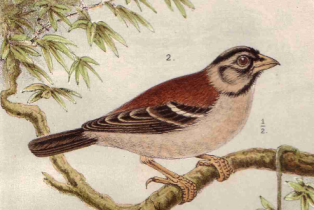
figure from Buttikofer 1888 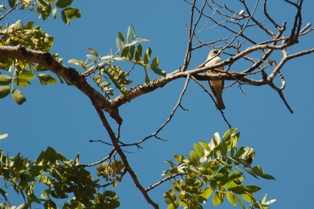
in miombo habitat 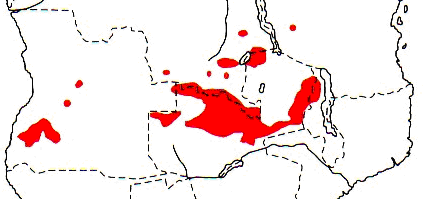
Distribution.
The Chestnut-mantled Sparrow-Weaver is found from south-west Angola, through SE DRCongo and Zambia to western Tanzania (near Mpanda) and north-western Malawi (see map right based on Birds of Africa).
Habitat. The Chestnut-mantled Sparrow-Weaver is restricted to miombo (Brachystegia) woodland. It sometimes joins mixed species flocks moving through the mid-stratum, and often perches inconspicuously in trees. Food. The diet of the Chestnut-mantled Sparrow-Weaver is seeds, including grass seeds, and it presumably also eats insects. Groups of up to 15 birds forage on the ground. Breeding. The mating system of the Chestnut-mantled Sparrow-Weaver is unknown but it may be a co-operative breeder like the White-browed Sparrow-Weaver. The Chestnut-mantled Sparrow-Weaver is colonial, with small groups of nests in Zambia, but in Angola, it is usually a solitary nester. The nest is an untidy domed mass of grass with 2 entrances, one of which is closed off when the eggs are laid, thus resembling the nest of the White-browed Sparrow-Weaver. The nest is placed in a cluster of small branches at the end of a branch in trees. The eggs are whitish, and heavily spotted with reddish brown at the thick end. Nothing else is known about its breeding habits. Bohm's Flycatcher Muscicapa boehmi has been recorded breeding in old nests of this weaver. |
The above is based on Weaver Wednesday, a weekly series about weaver species.
This species text first appeared as
Weaver Wednesday [67]: Chestnut-mantled Sparrow-Weaver on 2013-09-25
2. Breeding facts
| Pair bond No information; probably a co-operative breeder Breeding season Sept-Oct in Angola, Sept-Nov in Zambia and Oct-Mar in DRCongo Nest site placed up to 5 m above groud near end of branch in tree (Julbernadia or Brachystegia) Nest building n/a Colony size small groups of nests in a single tree in Zambia, solitary nests reported in Angola Clutch size No information Egg colour whitish, heavily spotted with reddish-brown at thick end Egg size No information Incubation No information Chicks and nestling period No information |
Breeding information based on Handbook of the Birds of the World, Vol. 15.
3. Photos of Weaver Nests
 Vm 11985 |
Thumb-nails of most recent PHOWN records - click on one to see its full record
See all PHOWN records for this species here.
PHOWN (Photos of Weaver Nests) provides valuable info on breeding distribution and colony sizes of weavers.
You can contribute by registering and submitting photos at Virtual Museum webpage.
4. Breeding distribution
Google map showing distribution (For species with small ranges you need to zoom in at the correct area to see the range):
yellow blob - range of weaver species; read more about this here.
![]() - PHOWN records with photos
- PHOWN records with photos
![]() - PHOWN records with no photos (Nest Record Cards, other records)
- PHOWN records with no photos (Nest Record Cards, other records)
![]() - Birdpix records
- Birdpix records
![]() - comments on out of range records, or interesting records
- comments on out of range records, or interesting records
![]() - type locality
- type locality
CLICK on the marker on the map to see individual record details.
5. Range changes
Not South African speciesThe above is based on Weaver Wednesday 3, a weekly series about range changes in South African weaver species.
This species text first appeared as
n/a







